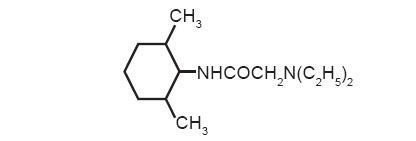Lidozion Lotion
Generic name:lidocaine hydrochloride
Dosage form: lotion
Drug class:Topical anesthetics
Medically reviewed by Drugs.com. Last updated on Aug 23, 2021.
Disclaimer: This drug has not been found by FDA to be safe and effective, and this labeling has not been approved by FDA. For further information about unapproved drugs, click here.
On This Page
DESCRIPTION
Contains lidocaine HCl 3%. Lidocaine is chemically designated as acetamide, 2-(diethylamino)-N(2,6-dimethylphenyl), and has the following structure:

C14 22 2H N O Mol.wt.234.34
Each gram of Lidocaine HCl 3% Lotion contains ACTIVE: Lidocaine HCl 30 mg in a lotion base of INACTIVES: Aluminum sulfate, calcium acetate, cetyl alcohol, glycerine, mineral oil, methyl paraben, white petrolatum, propyl paraben, purified water, sodium hydroxide, sorbitan stearate, stearic acid, stearyl alcohol, poly sorbate 60 and disodium EDTA.
Lidocaine HCl 3% Lotion releases lidocaine which stabilizes the neuronal membrane by inhibiting the ionic fluxes required for initiation and conduction of impulses, thereby effecting local anesthetic action.
Lidocaine may be absorbed following topical administration to mucous membranes, its rate and extent of absorption depending upon the specific site of application, duration of exposure, concentration and total dosage. In general, the rate of absorption of local anesthetic agents following topical application occurs most rapidly after intratracheal administration. Lidocaine is also well-absorbed from the gastrointestinal tract, but little intact drug appears in the circulation because of biotransformation in the liver.
Lidocaine is metabolized rapidly by the liver, and metabolites and unchanged drug are excreted by the kidneys. Biotransformation includes oxidative N-dealkylation, ring hydroxylation, cleavage of the amide linkage, and conjugation. N-dealkylation, a major pathway of biotransformation, yields the metabolites monoethylglycinexylidide and glycinexylidide. The pharmacological / toxicological actions of these metabolites are similar to, but less potent than, those of lidocaine.
Approximately 90% of lidocaine administered is exc...



